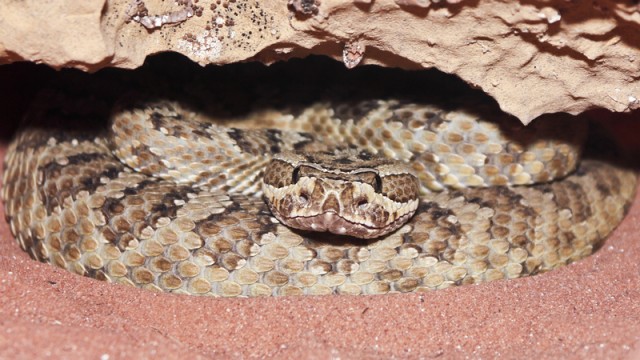Compared to other snakes on our list, the massasauga snake is relatively small, and this makes it more difficult to spot. Actually, this rattler is on the endangered species list in some states, so you’ll probably seldom come across one.
But if you are ‘lucky’ enough to encounter this snake, BEWARE: it is small but deadly! The venom from this snake is extremely nasty, so if you are bitten, you will need immediate help!
According to Wikipedia:
The Eastern Massasauga is listed as an endangered species in Illinois, Indiana, Iowa, Minnesota, Missouri (also considered extirpated), New York, Ohio, Pennsylvania and Wisconsin. Michigan, the only state in which it is not considered endangered, lists it as “special concern.”
3 – Massasauga
MASSASAUGA (Sistrurus catenatus). Length 24-27 inches. This snake belongs to a group of small rattlesnakes called “ground” or “pygmy” rattlers, which are differentiated from the larger rattlers by having paired scales on top of the head, as have the copperhead, cottonmouth, and non-poisonous snakes. The massasauga occurs in open fields and rocky outcroppings. It is particularly common in the Flint Hills. This is the “prairie rattler” of eastern Kansas, often found under hay bales in fields. Its food consists primarily of small rodents. The small size and usually docile disposition of this snake tend to place it upon the nondangerous list, but its venom is extremely toxic, and any bite from a poisonous snake is dangerous. When aroused, these small snakes strike with a fury not seen in the larger snakes. The rattling of this small snake is hardly louder than the buzz of a grasshopper.
The Massasauga snake may sound scary, but one of the most deadly snakes in the country is next on our list.
Learn which snake causes more death more than any other after the break:


Yes Obama. Clinton,Schumer palosi. McCain, cnn
Well , they all look democRATS ,but they are so many of them it’s hard to identify them.
I can identify them only in soup or stews,they fast different .
#1 John mccain#2loretta lynch#3 Hillary clinton#4 jey johnson#6 Maxine Watters,#5obama#
Lynch,OBumer,Schumer ,Pelosie
–
Chuck Shumer
Nancy Pelosi
Elizabeth Warren
John McCain
Maxine Waters
Hillary Clinton
Nope
Guessing here…copperhead, water moccasin, and 2rattlesnakes…..one might be a sidewinder?
Dead snake!
The most important detail about snake bites is the statistic that the great majority of them occur because the victim tried to handle, or kill the snake. They’re easily as afraid of humans as we are them, so just leave them alone.